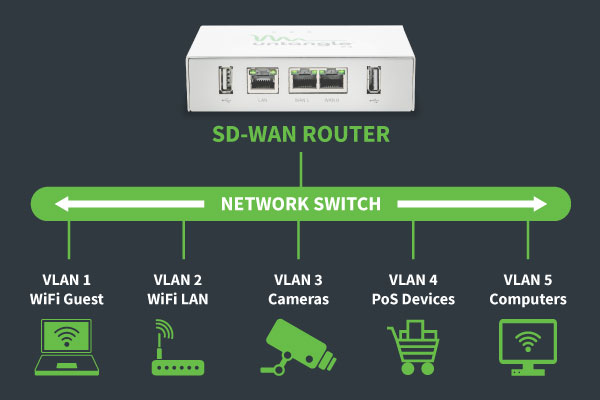VLANs Streamline Network Connectivity and Increase Security

Network administrators now have a new tool in their arsenal as they work to increase network efficiency and minimize operational costs. Using virtual local area networks, or VLANs, network administrators can segment network traffic and layer intelligence and prioritization over those segments to meet the connectivity needs of every department as well as business leaders.
VLANs, an extended benefit of software-defined networking (SD-WAN), breaks down how users connect to the network at large. With VLANs, network segmentation that previously required hardware with multiple physical WAN ports, can now be defined using a single physical WAN, virtually. Network administrators can create virtual network ecosystems for each department or device type, prioritizing business critical applications as needed.
Key Benefits of Using VLANS
- Makes device management easier: With this logical approach, devices can be grouped and managed together onto VLANs allowing rules to be put in place for specific devices. Adding new devices is easy since they just need to be added to a VLAN and the network settings already in place for that VLAN will be applied.
- Ability to group devices by function instead of location: VoIP phones, for example, are easily grouped and managed to increase network efficiency. Quality of Service rules can be applied to VoIP phones increasing call quality, and they can be routed directly to the internet with minimal processing by the firewall which frees up network resources.
- Adds additional layer of security: Devices can be segmented by VLAN, so they can only access the allowed resources. In Varonis’ 2021 Financial Data Risk Report, one of the key findings was that “nearly two-thirds of companies have 1,000+ sensitive files open to every employee.” With VLANs minimizing who has access across department and employment type, this vulnerability can be quickly addressed and mitigated.
- Improves ability to adapt to changes in network requirements: VLANs can logically group networks to decouple the users’ network location from their physical location. By using VLANs, one can control traffic patterns and react quickly to employee or equipment relocations.
- Reduces hardware investments across the network. Previously, to create this specific and detailed network segmentation, IT Teams were tasked with purchasing, managing, and replacing costly hardware as the business and network expanded. With VLANs, scale and agility are easily managed in a virtual environment, reducing the overall hardware footprint and increasing network performance.
Network Diagram using VLAN Segmentation
For example, in a medium-sized company with a headquarter location and two branch offices, network administrators can create VLANs at each branch office as needed to support the needs of each location. Point of Sale devices, that are always a priority to maintain connectivity to support the business operations, will be prioritized to ensure business continuity. Whereas, the guest WiFi users will be a lower priority, and also have restricted access to the internet only (no internal systems access). Thirdly, computers and WiFi LAN that need connectivity to specific businesses applications to be efficient, will be optimized above other general network traffic.

© 2024 Arista Networks, Inc. All rights reserved.